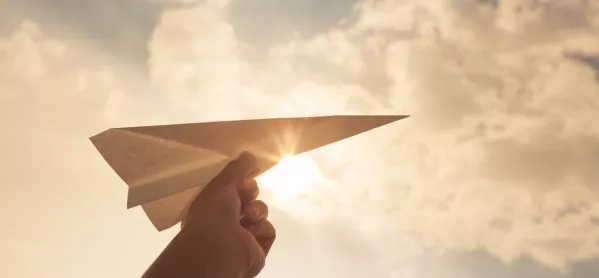Why a paper aeroplane challenge is no flight of fancy

Here in the USA every day seems to have a national designation.
Among the more popular days are National Doughnut Day (4 June) and National Teacher Day (4 May), but there are a whole host of more obscure ones: National Bacon Day (30 December) and National Answer the Telephone Like Buddy the Elf Day (18 December), for example.
However, while searching for some festive themes to underpin some Steam activities, I came across National Wright Brothers Day on 17 December - a day that actually seemed to have educational merit.
After all, it commemorates the first successful flights in a “heavier than air” plane made by the Wright Brothers, Orville and Wilbur, when they flew for 12 seconds, covering 112 feet, at an average height of 10ft.
This landmark flight paved the way for future innovation in aviation - and sparked an idea for a fun but genuinely useful end of term activity: a paper aeroplane competition.
An idea takes flight
The intention is to have each class work on folding and designing paper aeroplanes, to see who can come up with a plane that will travel the furthest.
By focusing on paper aeroplanes, it is a low -esource, easy session to organise in the last week of term, and there are lots of helpful resources out there, such as the fantastic website Fold N Fly, which offers step by step instructions for all sorts of paper aeroplanes.
Before that, though, the competition will start with some research about the Wright Brothers, either reading a book for younger children, or a mini-biography writing task for older children, meaning all children who are learning virtually can access the competition at home easily, too.
For those learners at home, the hope is that they will fly their planes and record the distances to send in, so they can help their class, too.
Collaboration over competition
Following on from this, the plan is to have the children work together as a class - sharing their ideas, successes and failures, and folding tips during the session.
I don’t want it to be a competition with an individual child winning. Instead, I want a class to win as a whole, to recognise the importance of collaboration - in the spirit of the Wright Brothers working together.
We will then head to the gym for the great “throw-off” competition. The class will stand along one of the many lines covering the floor and, on the count of three, launch their planes.
Children dialling in can spectate and throw their plane simultaneously with their friends in school.
Celebrating the Wright Brothers
The way the winner will be determined will be through the distance the paper plane has flown. Each year group will measure in an age-appropriate way. Early years might just look and compare how far the planes have flown to see who has reached the furthest, using simple positional language to compare.
Key stage 1 may use non-standard units of measure to count how far the plan has flown, and the expectation will be for KS2 to use standard units to measure and compare the flights.
Each year group will have a class winner and the whole class will get a certificate, awarded in assembly.
In addition, there will be a trophy for the class that created the plane that travelled the furthest, throughout the school.
The best paper aeroplane
A trophy has been made from a wooden hand (the kind used to draw from), painted gold, and this will then hold the winning plane. This will also be awarded in a celebration assembly.
The hope is for the whole school to come together - virtually and in-person - to end the term with a fun Steam-inspired competition, and to recognise an important day in both American, and world, history.
Tom Collins is a primary science specialist teacher and Steam departmental leader at the Nord Anglia British International School of Chicago - Lincoln Park
You need a Tes subscription to read this article
Subscribe now to read this article and get other subscriber-only content:
- Unlimited access to all Tes magazine content
- Exclusive subscriber-only stories
- Award-winning email newsletters
Already a subscriber? Log in
You need a subscription to read this article
Subscribe now to read this article and get other subscriber-only content, including:
- Unlimited access to all Tes magazine content
- Exclusive subscriber-only stories
- Award-winning email newsletters